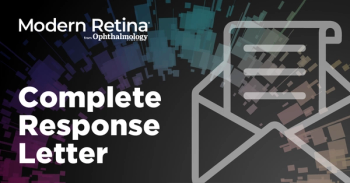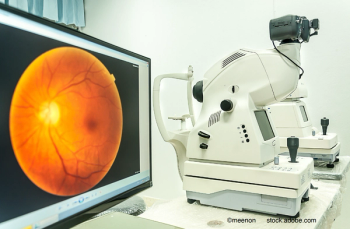
GA therapies coming down the pike
Katherine Talcott, MD, discussed other potential therapies and their mechanisms of action being evaluated in clinical trials at the OSN New York 2024 conference.
Reviewed by Katherine Talcott, MD
There is a great need for more effective treatments for geographic atrophy (GA) secondary to age-related macular degeneration (AMD) to reduce individual and societal burdens.Clinicians currently have 2 FDA-approved drugs, pegcetacoplan (Syfovre, Apellis Pharmaceuticals) and avacincaptad pegol (Izervay, Iveric Bio), that require frequent intravitreal injections every 1 to 2 months.
Katherine Talcott, MD, discussed other potential therapies and their mechanisms of action being evaluated in clinical trials at the OSN New York 2024 conference. She is an Assistant Professor of Ophthalmology, Cole Eye Institute, Cleveland Clinic, Cleveland.
“Despite advances in the treatment of neovascular AMD, treatments for GA remain elusive,” she emphasized.
Complement pathway
ANX007 (Annexon) is an antibody that inhibits C1q, which accumulates on drusen in aging eyes with GA and initiates the classical complement cascade in AMD. When administered intravitreally, ANX007 blocks the downstream activation of the complement cascade, she explained.
In the phase 2 ARCHER Trial,1-4 ANX007 was compared with sham dosed monthly or every other month. The results showed significant, time- and dose-dependent protection from vision loss, defined as a loss of the best-corrected visual acuity (BCVA) of 15 or more letters.
After 12 months, there was a 72% reduction in the risk of a 15-letter or greater BCVA loss with monthly dosing and a 48% risk reduction with every-other-month dosing compared with sham. The safety profile showed few incidences of choroidal neovascular conversion, endophthalmitis, and intraocular inflammation and retinal artery occlusion, neither of which was associated with retinal vasculitis.
Danicopan ALXN 2040 (Voydeya, Alexion Pharmaceuticals, Inc.) is an oral agent that inhibits complement factor D and prevents activation of an alternate pathway, blocking inflammatory response and cell lysis.
In an ongoing phase 2 dose-finding study5 (NCT05019521) that included about 332 patients without foveal involvement, 3 doses are being tested: 100 and 200 mg twice daily and 400 mg once daily, and compared with placebo. The study includes a screening period up to 6 weeks, a 104-week masked treatment period, and a 30-day follow-up after the last dose.
AVD-104 (Aviceda Therapeutics) is a sialic acid-coated nanoparticle that binds to specific sialic acid-binding immunoglobulin-type lectin receptors and repolarizes overactivated macrophages into their resolution phenotype and also binds to and up-regulates complement factor H.
The treatment consists of 1 intravitreal injection that is being evaluated in the phase 2/3 SIGLEC study.6 The part 1 results showed that 80% of the first patients who reached the 3-month endpoint had visual acuity gains. Part 2 will include 290 patients.
Gene therapy
JNJ-1887 (Johnson & Johnson), the phase 2b Parasol Geographic Atrophy Study, a 1-time intravitreal injection (AAVCAGsCD59) is being evaluated. The treatment was designed to increase expression of the soluble recombinant version of CD59 by inhibiting membrane attack complex formation, the terminal step in complement-mediated cell lysis, and protecting the retinal cells.7
In the phase 1 study,7 3 doses met the primary safety endpoint over a 2-year follow-up period. The results also showed promising efficacy measures for the high-dose cohort with a continual decline in lesion growth over 6-month intervals, Talcott reported.
ASP7317 (Astellas) is a subretinal therapy derived from human embryonic stem cell-derived retinal pigment epithelial (RPE) cells. The phase 1b trial includes 18 patients and is evaluating 3 doses of ASP7317 via vitrectomy with a subretinal injection along with immunosuppressive therapy. The primary outcomes are safety/tolerability at 52 weeks; secondary endpoints include changes in the GA lesion area and BCVA at week 52 compared with baseline.8
RG6501 (OpRegen, Lineage Cell Therapeutics, Genentech) is a suspension of human allogeneic RPE cells delivered subretinally. In a phase 1 study, the outer retinal structure improved in 5 patients and the 1-year mean gain in the BCVA was 12.8 letters. Phase 2 is currently enrolling patients.9
Treatments on the horizon
Elamipretide (Stealth Biotherapeutics) is a tetrapeptide that targets cardiolipin in mitochondria, reducing reactive oxygen species production. The phase 1 ReCLAIM study evaluated subcutaneous delivery of elamipretide for 24 weeks to treat dry AMD with non-central GA and showed possible positive effects on visual function.10
ReCLAIM-2 achieved a 43% reduction in the progression of the ellipsoidal zone (EZ) total attenuation versus placebo (p=0.003) and a 47% reduction in the progression of partial EZ attenuation (p=0.004) and improved low-light visual function.
Phase 3 ReNEW and ReGAIN will evaluate once-daily subcutaneous injections of elamipretide.
Glideuretinal (ALK-001) and AREDS/AREDS2 are antioxidants.
The former is an oral form of vitamin A being evaluated in the ongoing phase 3 SAGA trial to determine the efficacy and safety in about 300 patients with GA secondary to dry AMD.
The latter is a vitamin and mineral supplement that showed greater than 33% reduced odds of developing advanced AMD in high-risk patients. The AREDS2 is a newer that replaced beta-carotene with lutein/zeaxanthin, and intake was associated with a similar reduced risk of developing advanced AMD; it also eliminated the increased risk of lung cancer associated with beta-carotene.11-13
ONL1204 (ONL Therapeutics) is a Fas inhibitor for reducing Fas-mediated retinal cell apoptosis and inflammatory cytokines.
A phase 1b part 1 safety assessment of 1 intravitreal injection showed early efficacy with an average reduction in GA lesion growth of 42% at 6 months. In part 2, 2 injections administered 3 months apart resulted in reduced lesion growth by about 50%. A phase 2 study is starting.14
References
Jiao H, Rutar M, Fernanndo N, et al.
Subretinal macrophages produce classical complement activator C1q leading to the progression of focal retinal degeneration . Mol Neurodegen. 2018;13:45.Grover A,
Sankaranarayanan S, Mathur V, et al. Pharmacokinetic and target engagement measures of ANX007, an anti-C1q antibody fragment, following intravitreal administration in nonhuman primates. Invest Ophthalmol Vis Sci. 2023;64:3.Lally D. Treatment of geographic atrophy secondary to age-related macular degeneration with intravitreal ANX007, a selective classical complement inhibitor: results of the ARCHER Study. Presented at the 2023 American Academy of Ophthalmology Annual Meeting, November 3-6, 2023.
Boyer DS, et al. Protection against Vision Loss by ANX007: Results from the Phase 2 ARCHER Clinical Trial. ARVO 2024.
Rajanala K, Dotiwala F, Upadhyay A. Geographic atrophy: pathophysiology and current therapeutic strategies.
Front Ophthalmol . 2023;3;https://doi.org/10.3389/fopht.2023.1327883 https://www.avicedarx.com/news ; accessed 2024https://www.jnj.com/media-center/press-releases/johnson-johnson-highlights-commitment-to-transform-treatment-of-retinal-diseases-at-arvo-2024 ; accessed 2024https://www.clinicaltrials.astellas.com/study/7317-CL-0003; accessed 2024
https://eyewire.news/news/genentech-launches-phase-2a-study-of-rg6501-opregen-in-patients-with-geographic-atrophy?c4src=article:infinite-scroll; accessed 2024
https://eyewire.news/news/https://stealthbt.com/stealth-biotherapeutics-announces-first-patient-enrolled-in-global-phase-3-clinical-program-for-elamipretide-in-patients-with-dry-age-related-macular-degeneration/; accessed 2024
Sangiovanni JP, Agron E,
Dhananjayan Meleth A, et al. Omega-3 long-chain polyunsaturated fatty acid intake and 12-y incidence of neovascular age-related macular degeneration and central geographic atrophy: AREDS report 30, a prospective cohort study from the Age-Related Eye Disease Study. Am J Clin Nutr. 2009;90:1601-1607.Chew EY, Clemons TE, Sangiovanni JP, et al. Secondary analyses of the effects of lutein/zeaxanthin on age-related macular degeneration progression: AREDS2 report No. 3. JAMA Ophthalmol. 2014;132:142-149
Chew EY, Clemonns TE, Agron E, et al. Long-term outcomes of adding lutein/zeaxanthin and ω-3 fatty acids to the AREDS supplements on age-related macular degeneration progression: AREDS2 Report 28. JAMA Ophthalmol. 2022;140:692-698.
https://www.onltherapeutics.com/clinical-trials/ ; accessed 2024
Presentation reference
Talcott KE. Pipeline Treatment for GA. Presented at OSN New York 2024, November 8-10, New York. Session: All About Geographic Atrophy, November 9, 2024.
Newsletter
Keep your retina practice on the forefront—subscribe for expert analysis and emerging trends in retinal disease management.

















































